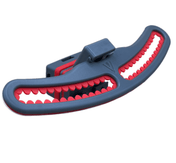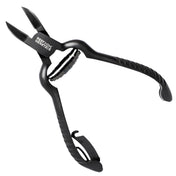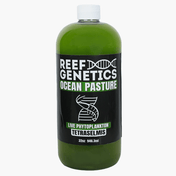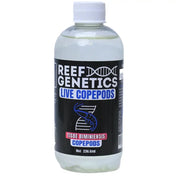ALMOST WYSIWYG – Approx. Size: 1.5-3 Inches
Ocellaris Clownfish (Amphiprion ocellaris)
Ocellaris Clownfish, often referred to as the “Nemo” fish, are one of the most iconic and beginner-friendly species in the saltwater aquarium hobby. With their vibrant orange bodies, bold white bands, and lively personalities, they bring energy and charm to any reef setup. These captive-bred fish are hardy, adaptable, and ideal for aquarists of all experience levels.
Tank Requirements
Ocellaris Clownfish thrive in aquariums of 20 gallons or more, with ample swimming space and live rock for exploring and hiding. They can be kept solo, in bonded pairs, or even in small harems in larger systems. While they don’t require a host anemone, many will readily adopt soft corals or LPS as substitutes.
Captive-Bred and Hardy
Captive-bred Ocellaris are well-suited to aquarium life—more disease-resistant, less aggressive, and easier to feed than their wild counterparts. Their peaceful temperament and adaptability make them perfect residents for both nano reefs and larger community tanks.
Diet and Feeding
Omnivorous by nature, these clownfish readily accept a wide variety of foods. Feed a balanced mix of high-quality pellets or flakes, frozen mysis and brine shrimp, and occasional chopped seafood or algae-based foods. Regular feeding helps maintain their vibrant coloration and overall health.
Tankmates and Behavior
Ocellaris Clownfish are peaceful and reef-safe, making them ideal companions for a variety of fish and invertebrates. While generally non-aggressive, they may show territorial behavior when breeding or defending a host. Compatible with most community reef fish, they add both beauty and animation to any saltwater setup.
Introduction to Saltwater Clownfish
Clownfish are among the most popular and recognizable marine fish, known for their bright colors, hardy nature, and fascinating symbiotic relationships with anemones. Native to tropical reefs in the Indo-Pacific, these fish thrive in reef aquariums of all sizes, making them an excellent choice for both beginners and experienced aquarists. Clownfish are incredibly adaptable, and many aquacultured varieties are available, making them easier to care for and less aggressive than wild-caught specimens.
Care Requirements
Care Level: Easy Minimum Tank Size: 20 – 50+ gallons Ocellaris & Percula Clownfish – 20+ gallons (smaller and more peaceful) Maroon Clownfish & Larger Varieties – 50+ gallons (more aggressive, need more space) Aquarium Setup: Prefers rock structures for hiding and stable water conditions.
Diet & Nutrition
Clownfish are omnivores and thrive on a varied diet that includes both meaty and plant-based foods. Diet: Omnivorous – Eats a mix of proteins and algae
Recommended Foods:
High-quality marine pellets and flakes Frozen mysis and brine shrimp Chopped seafood and enriched frozen foods Algae-based foods (spirulina, seaweed sheets) Feeding small portions 1-2 times per day ensures optimal health, vibrant coloration, and proper growth.
Lifespan & Growth Rate
Lifespan: 6-10+ years Growth Rate: Moderate – Most species reach 2-6 inches depending on the variety With proper care, clownfish can live over a decade in captivity, making them a long-term commitment for aquarists.
Temperament & Compatibility
Temperament: Peaceful to Semi-Aggressive – Can become territorial as they mature Reef Safe? Yes – Clownfish do not harm corals or invertebrates Clownfish are peaceful fish but may become territorial as they establish their space, especially when paired with an anemone. To ensure compatibility: Best kept in pairs or small groups—but avoid mixing different clownfish species in small tanks. Introduce them before more aggressive fish to help them establish their territory. Compatible with most reef-safe community fish, including wrasses, gobies, and tangs.
Common Challenges & Considerations
Aggression in Larger Species: Maroon Clownfish and Tomato Clownfish can be highly territorial and may bully tankmates. Hosting with Anemones: While not required, clownfish may form a symbiotic bond with certain anemones like Bubble Tip Anemones (Entacmaea quadricolor). However, not all clownfish will host anemones in captivity. Jumping Risk: Clownfish can jump out of open-top tanks, so a lid or mesh cover is recommended. Water Conditions Temperature: 74-80°F dKH (Alkalinity): 8-12 pH: 8.1-8.4 Specific Gravity: 1.020-1.025 Clownfish are hardy and adaptable, but stable water parameters are essential for long-term health.
Color Varieties & Popular Species
Clownfish come in a wide variety of colors and patterns, with many aquacultured morphs available. Some of the most popular species include: Ocellaris Clownfish (Amphiprion ocellaris) – Classic "Nemo" appearance, available in wild-type and designer morphs Percula Clownfish (Amphiprion percula) – Similar to Ocellaris but with brighter colors and thicker black outlines Maroon Clownfish (Premnas biaculeatus) – Deep red coloration, highly territorial and best kept alone or in pairs Snowflake Clownfish (Amphiprion ocellaris variant) – White and orange designer morph with irregular banding
At Top Shelf Aquatics, we take pride in ensuring your order arrives safely and in perfect condition. Here’s everything you need to know about our shipping process:
Livestock Shipping Details
- Flat Rate Shipping:
- $39.99 Out of State
- $34.99 Florida (In-State)
- Orders over $299 ship FREE!
- NO FREE Shipping during Sale Events
- Shipping Days: The calendar during checkout determines when your livestock order will arrive. Normally we ship Monday - Thursday via FedEx Priority Overnight.
Orders placed by 2 PM EST Monday - Thursday ship the same day. Orders placed after 2 PM or on Fridays will ship the next business day. - Delivery Times: Most packages arrive by 10:30 AM EST, though remote areas may experience later deliveries.
We take every measure to protect your livestock, including specialized packaging to maintain temperature and safety during transit.
Dead on Arrival (DOA) Policy
In the rare event of a DOA, you must submit a DOA Request within 2 hours of delivery (FedEx posted time). Once submitted, we will issue a replacement or store credit for the livestock. Please note:
- Shipping costs are not included in the credit.
- Refunds are not offered for livestock or shipping.
While we cannot be held responsible for delays caused by mechanical or weather issues, rest assured we’ll do everything possible to make it right!
Reef Guard Protection Plan
For ultimate peace of mind, upgrade to our Reef Guard Protection Plan. With Reef Guard, you’ll enjoy:
- Extended Livestock Guarantee: Coverage for up to 5 days.
- Priority Resolutions: Hassle-free claims with fast resolutions.
- Weather & Shipping Delay Coverage: Includes FedEx lost packages and damages.
Shipping Restrictions
- We currently ship livestock only within the continental U.S.
- Note: Due to Hawaii state law, we are unable to ship corals to Hawaii.
Now’s the perfect time to prepare your aquarium for its new additions. Consider doing a water change and ensuring space is ready. Check out our YouTube channel for detailed care instructions for your new corals!
For any questions or concerns, feel free to reach out to our support team. We’re here to help make your reefing journey a success!
5 Day Reef Guard
Temp-Control Box
Priority Overnight
Expert Care Support





















